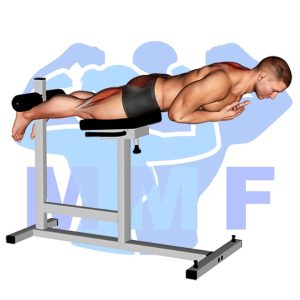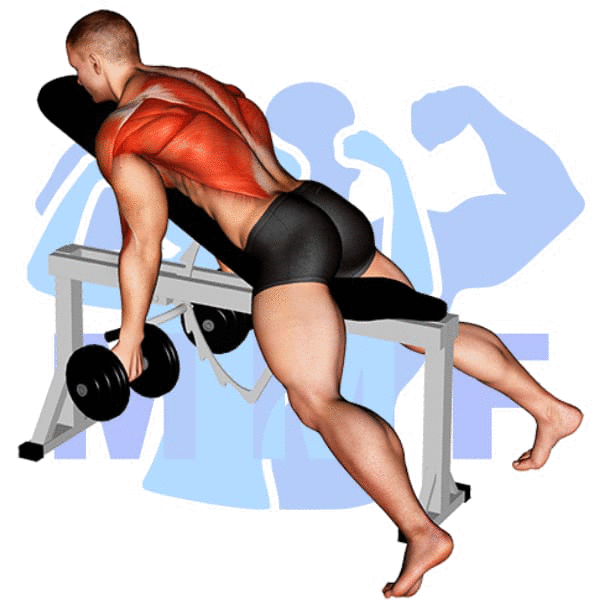Have you been struggling to achieve those defined abs? Do you find regular sit-ups too easy? Well, you might want to try a decline twisting sit up! But fear not, if you’re finding it difficult to execute these exercises, you’re not alone. One common cause of difficulty with this exercise is a lack of understanding of proper form and technique. But not to worry, in this blog post, we’ll guide you through the best techniques to perform a decline twisting sit up like a pro and help you achieve the strong sculpted abs you desire!
Decline Twisting Sit Up Summary
- Primary Muscles: Obliques
- Secondary Muscles: Quadratus lumborum, Psoas major, Iliocastalis lumborum, and Iliocastalis thoracis
- Equipment: Decline Bench
- Mechanics Type: Isolated
- Force: Pull
- Utility: Auxiliary

Decline Twisting Sit Up Instructions
- Hook your feet under the foot bar and lie supine on an incline bench with your knees bent.
- Place your hands behind neck. Flex and twist your waist to raise your upper torso from the bench to one side.
- Return until the back of your shoulders contact the padded incline board.
- Repeat by alternating your twist to the other side.
- Continue your Decline Twisting Sit-Ups alternating sides each rep for a full set.
Video Tutorial
Decline Twisting Sit Up Muscles
Target (Agonist)
Synergists
- Quadratus lumborum
- Psoas major
- Iliocastalis lumborum
- Iliocastalis thoracis
Dynamic Stabilizers
- None
Stabilizers
Antagonist Stabilizers
- None

Benefits of Decline Twisting Sit Up
The decline twisting sit up is a great exercise for targeting the oblique muscles. This exercise works the oblique muscles by having the participant twist the torso to one side while performing a sit up. This move not only targets the obliques, but also helps to improve core stability, build strength in the abdominal muscles, and increase flexibility in the spine. By incorporating this exercise into a regular strength training or fitness routine, people can benefit from increased muscular endurance and improved posture. Furthermore, this exercise can help to reduce the risk of lower back pain due to its ability to strengthen the muscles that help to support the spine.
Tips for Performing Decline Twisting Sit Up
You’ve come at the right location if you desire to forge ahead your ability to perform decline twisting sit up. These tips will get you more from of this effective workout, while helping you receive all the benefits it has to offer. Concurrently with building your obliques muscles, improving mobility, and also a lower chance of injury can all be accomplished with this exercise. Let’s get started and take a look at how these suggestions will help you.
- Make sure you have a mat or towel on the floor to protect your lower back: This will help you maintain proper form and provide cushioning for your spine during the exercise.
- Focus on quality reps: This will help ensure you’re getting the most out of the exercise and avoiding any potential injury.
- Increase the intensity: To challenge yourself further, add a twist at the top of each rep to really fire up those core muscles and give you an extra burn!
Benefits and Tips Video
Frequent Mistakes To Avoid
Avoiding common errors can be the distinction between a successful training session and an injury when executing decline twisting sit up. Additionally, in order to maximize the benefits of the exercise, proper form is essential. Through avoiding common errors, you can raise your performance and get your desired results. Don’t worry, though, it’s not nearly as hard as it might seem. You can perform the exercise safely and efficiently by understanding the mistakes to prevent and by following the proper steps. So let’s get started on how to avoid those typical mistakes and making this exercise a normal part of your fitness routine.
- Not engaging their core muscles: Not engaging their core muscles during the decline twisting sit up puts undue strain on their lower back and neck, which can lead to injury.
- Going too fast: Going too fast during the decline twisting sit up can cause them to lose form and increase their risk of injury.
- Not using a spotter: Not using a spotter during the decline twisting sit up can lead to them getting stuck in an awkward position, or even slipping and falling off of the decline bench.
Find More Bodyweight Exercises Here
Variations and Complementary Exercises
In addition to the Decline Twisting Sit Up, there are several other exercises that can be used to strengthen the same muscles and provide a similar workout. These exercises include variations, complementary, or alternative exercises that can help you reach your goals. The following list will provide a few examples of these exercises.
Cross Oblique Crunch

Cross Oblique Crunch is an alternative or complementary exercise to the Decline Twisting Sit Up. The Cross Oblique Crunch is a crunch exercise that works the obliques and abdominal muscles. It is performed on a flat surface with your feet together and your hands behind your head. You lift your shoulder blades off the ground while keeping your lower back in contact with the ground. You then twist your torso towards one side and crunch up, bringing your elbow towards your opposite knee. This is a great exercise to target the obliques and can be done in a variety of ways, such as with a medicine ball or a cable machine. It is also an effective way to tone the abdominal muscles and improve overall core strength.
Cable Stability Ball Russian Twists

Cable Stability Ball Russian Twists are a great complementary or alternative exercise to Decline Twisting Sit Ups. This exercise involves lying on your back and holding a cable stability ball overhead, with your feet and legs extended and elevated off the ground. From there, you twist your torso from side to side while keeping the ball overhead, providing an effective core workout. This exercise works the same muscles as Decline Twisting Sit Ups, but with a slightly different angle, making it an ideal variation to switch up your core routine.
Weighted Russian Twist

The Weighted Russian Twist is an excellent complementary or alternative exercise to the Decline Twisting Sit Up. This exercise focuses on strengthening the abdominal muscles as well as the obliques, and it also targets the hip flexors and the back muscles. It involves sitting on the floor with the feet slightly off the ground and then twisting the torso from side to side while holding a weight in both hands. This exercise is beneficial for increasing core strength and stability, and it can be done with lighter weights or heavier weights for those looking for more of a challenge.
Check Out These Top Bodyweight Exercises
Side Plank

Side Plank is an excellent alternative or complementary exercise to the Decline Twisting Sit Up. It strengthens the core muscles and improves balance and stability, while also engaging the obliques and glutes. It can be done either on the right or left side, with the elbow placed directly under the shoulder and the legs stacked one on top of the other. To increase the intensity, you can add a leg lift to the side plank. This exercise will not only help to strengthen the core, but will also help to build overall strength in the upper body.
Side Bridge Hip Dip

Side Bridge Hip Dip is a great complementary or alternative exercise to the Decline Twisting Sit Up. It helps to strengthen and tone the abdominal muscles and obliques, while also engaging the hip flexors and stabilizer muscles. This exercise can be done with just body weight, making it an accessible and versatile option for anyone. It is especially beneficial for those looking to increase core strength and stability as well as improve posture. The movement also helps to target and work the deep core muscles, helping to build a strong foundation for other exercises.
Horizontal Pallof Press With Bands

The Horizontal Pallof Press with Bands is a great complementary or alternative exercise to the Decline Twisting Sit Up. It is an effective core exercise that focuses on strengthening the abdominal and oblique muscles, while also improving hip and trunk stability. The exercise is performed by standing with feet hip-width apart and a resistance band attached to a stationary object in front of you. The band is held out at chest level, and you will press it away from your body while keeping your core tight and your hips and shoulders square. You will then return the band to the starting position and repeat for the desired number of repetitions. This exercise is great for challenging the core muscles without putting strain on the lower back.
Find More Abs Exercises Here
Opposing Complementary Exercises
It is important to use exercises that work the opposite muscle groups of the Decline Twisting Sit Up in order to create balance in your workout. Doing so will help you avoid overworking one particular muscle group and promote overall body strength and stability. Here are some exercises that can help you achieve this:
Hyperextension

Hyperextension is a great way to complement the Decline Twisting Sit Up exercise, as it works the opposing muscle group. Hyperextension requires you to lie face down on a bench with your feet secured and your hips suspended in the air. From this position, you arch your back and then return to the starting position. This exercise works the lower back, glutes, and hamstrings, which are the opposing muscle groups to the Decline Twisting Sit Up that works the abdominals and obliques. Working these opposing muscle groups will increase your overall core strength, which can lead to better posture and improved performance in other activities.
Reverse Hyperextension

Reverse Hyperextension is a great complement to the Decline Twisting Sit Up exercise. It works the opposing muscle group, helping to ensure balance and stability in the core. Reverse Hyperextension focuses on strengthening the lower back, glutes, and hamstrings. This exercise works these muscles by having the user lie face down on a bench and slowly raise their legs up while keeping their torso on the bench. By doing this, the user strengthens their lower back and glutes while also working their hamstrings as they control their leg movement. This exercise compliments Decline Twisting Sit Up by providing balance and stability to the core while also allowing for further core strength development.
Plate Hyperextension

Plate Hyperextension is an excellent complement to the Decline Twisting Sit Up exercise. This exercise works the lower back and glutes, which are the opposing muscle groups to the abdominals used in Decline Twisting Sit Up. Plate Hyperextension works the lower back and glutes by having you lie face down on a flat bench or platform with a weight plate placed on your lower back. You then raise your upper body and hips off the bench, hold for a few seconds and then return to the starting position. This exercise strengthens the muscles of your lower back and glutes, creating balance with the abdominals and helping to build a strong core.
Get Stronger Abs With Decline Twisting Sit-Ups
If you want to get stronger abs, then decline twisting sit-ups may be the right exercise for you. These are sit-ups that are performed on a bench at a decline angle, which increases resistance and makes the exercise more challenging. Twisting sit-ups also work the oblique muscles that run along the sides of your waistline, giving you a more defined waistline. This exercise is a great way to target different muscle groups in your core and build a stronger foundation for other exercises. Make sure to use proper form and start with lower weights to prevent injury and gradually build up.
References: Wikipedia | ExRx.net | PubMed.gov | Comprehensive List of Abs Bodyweight Exercises




